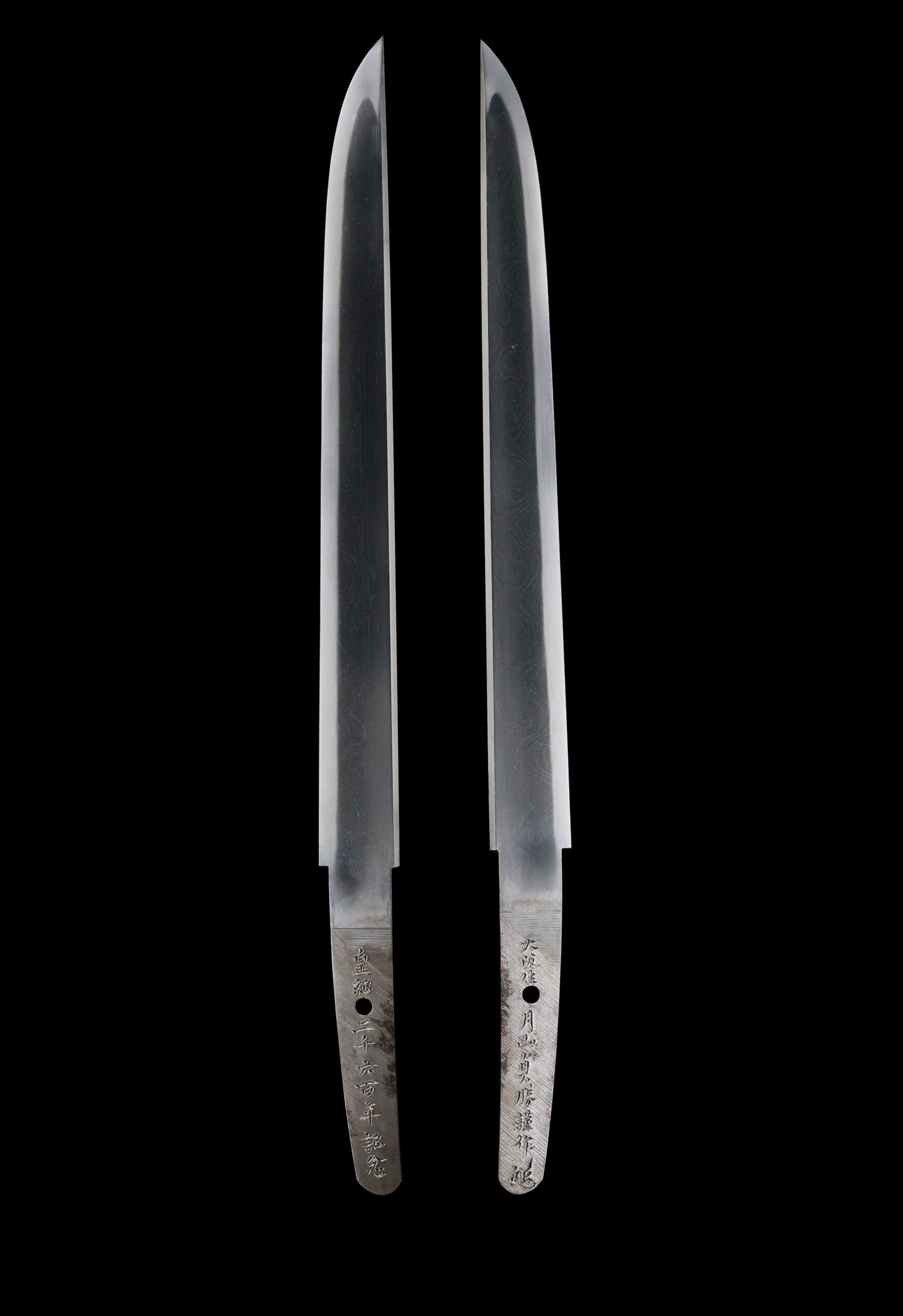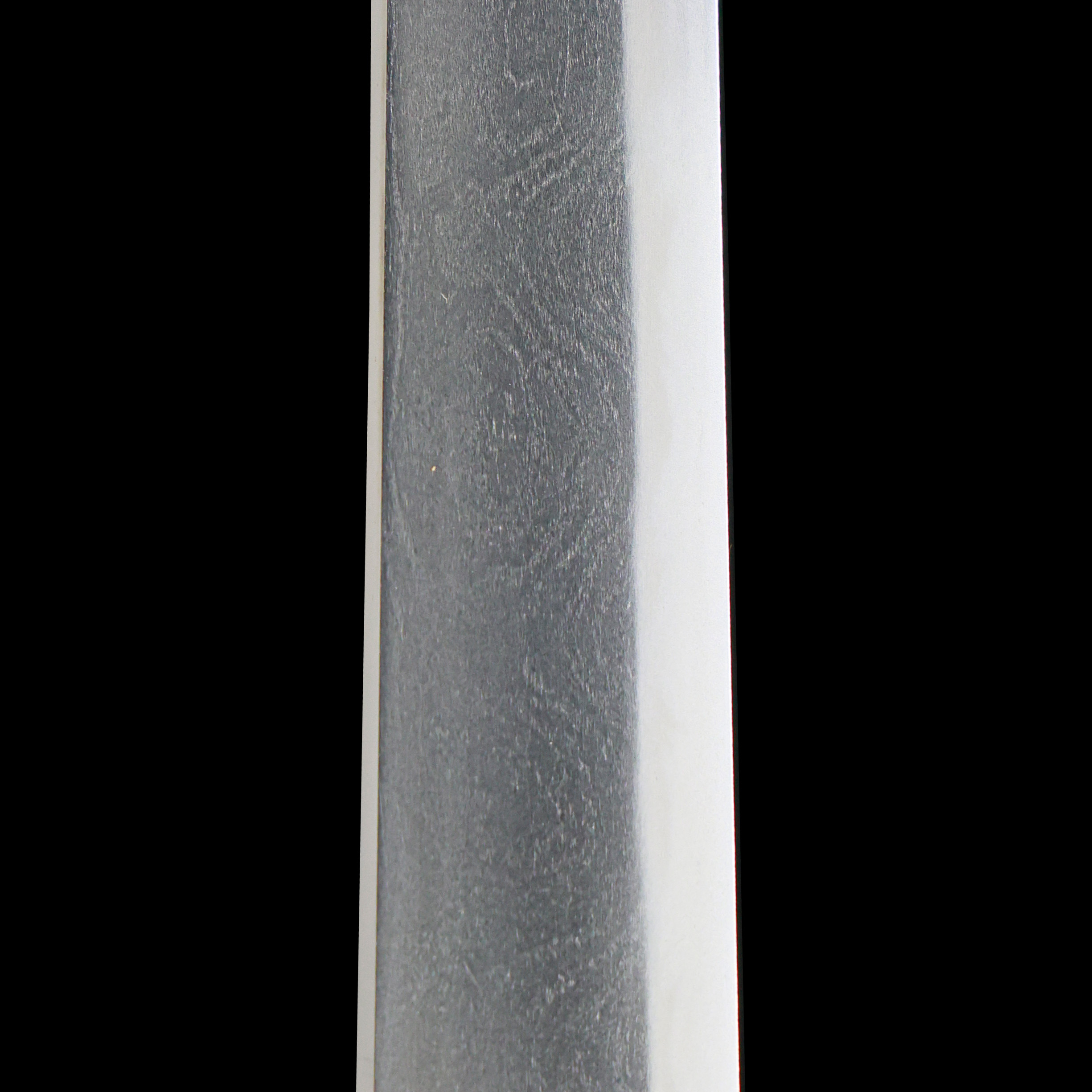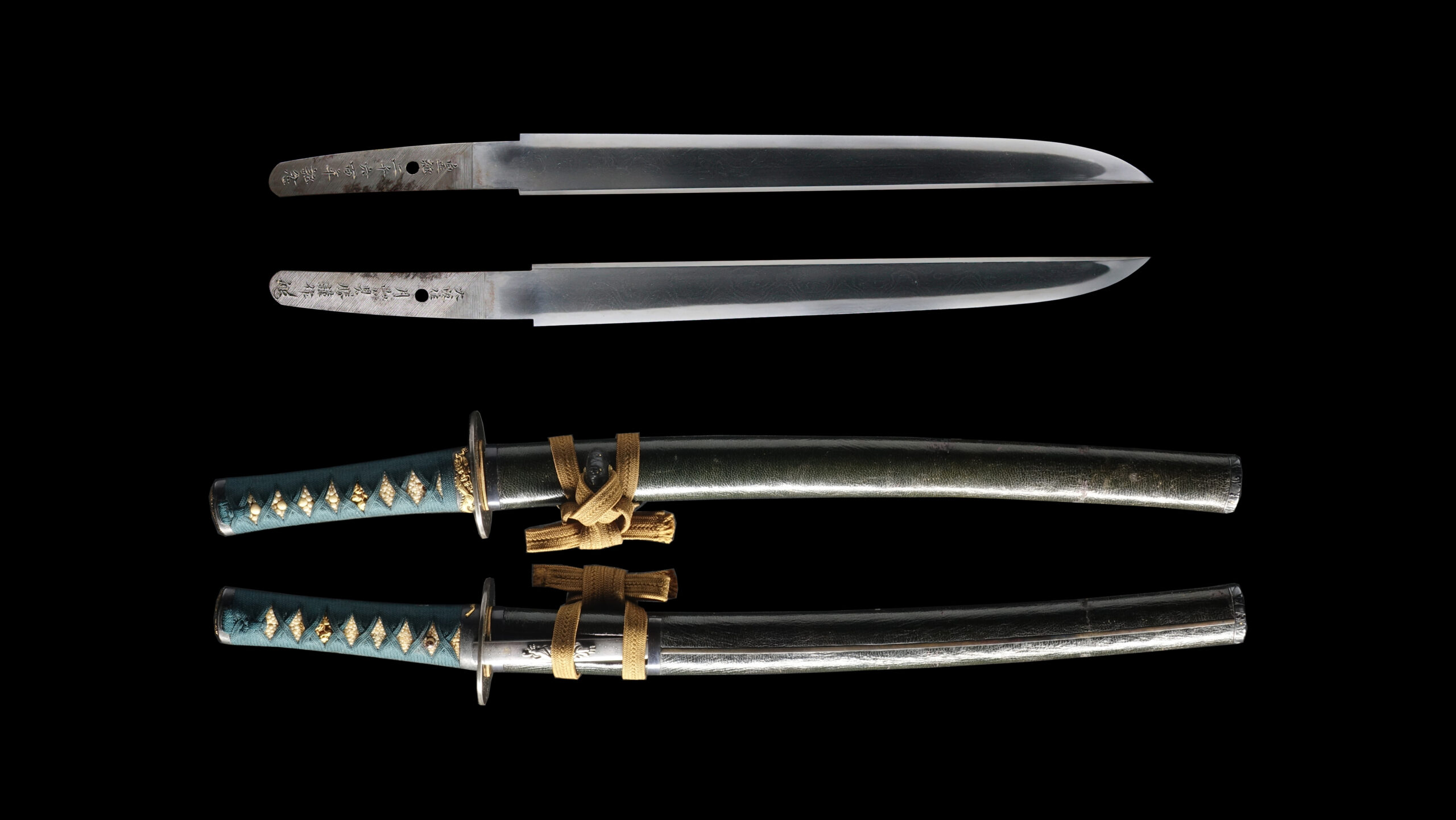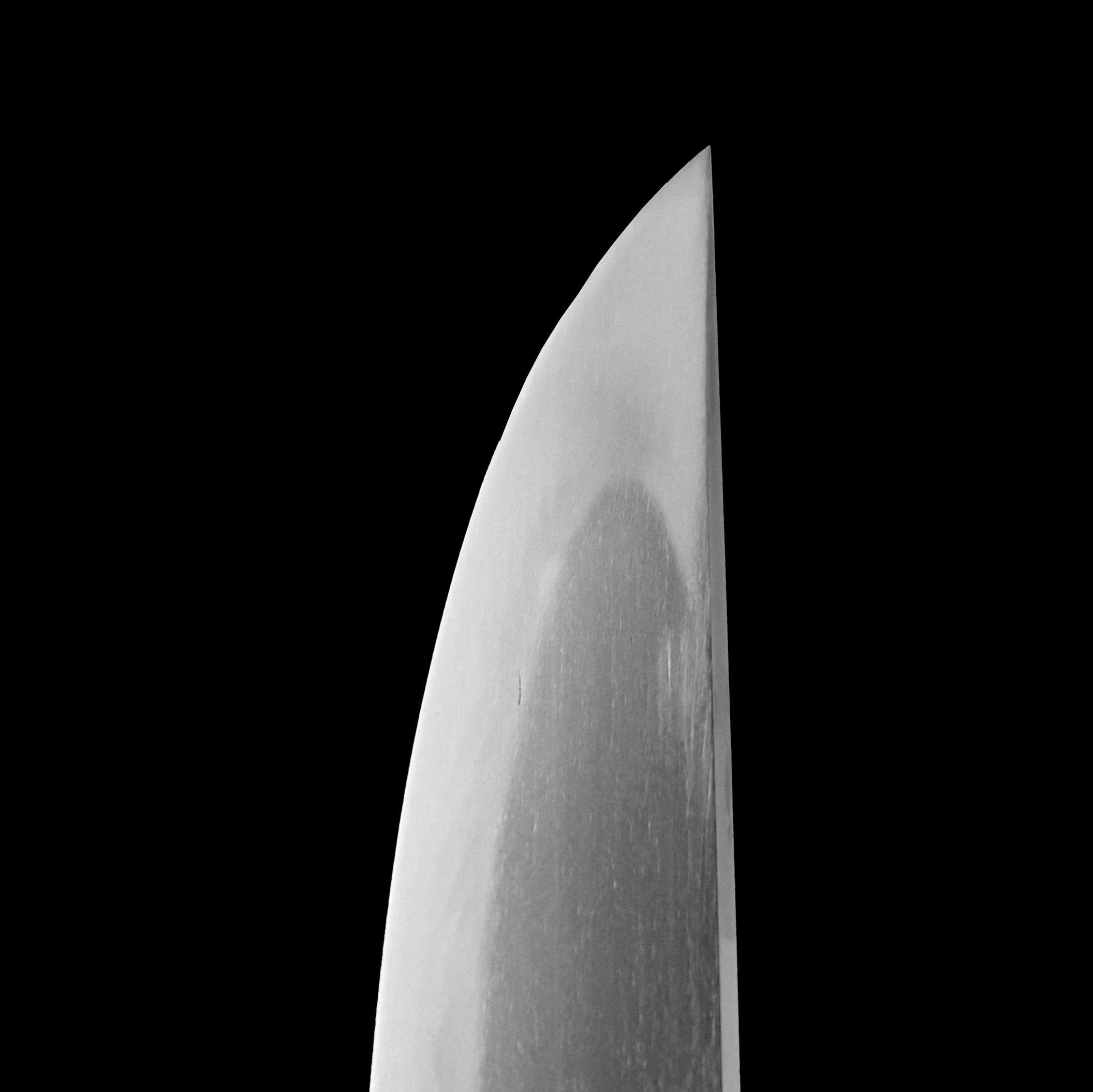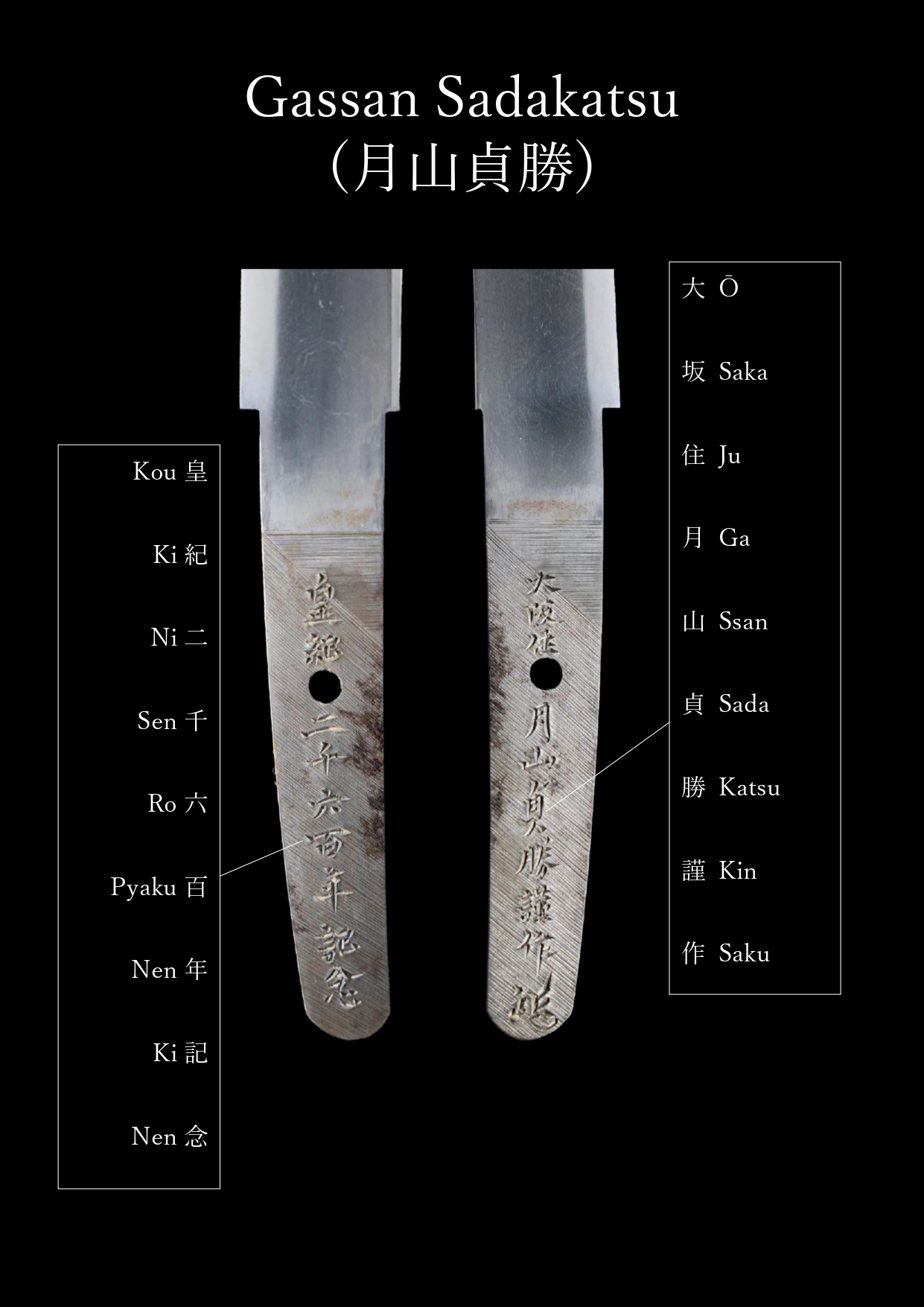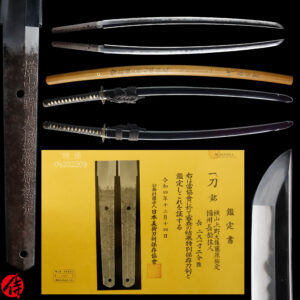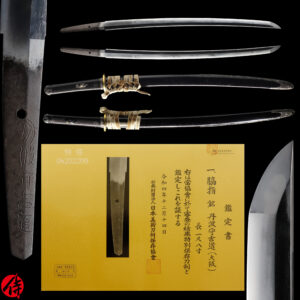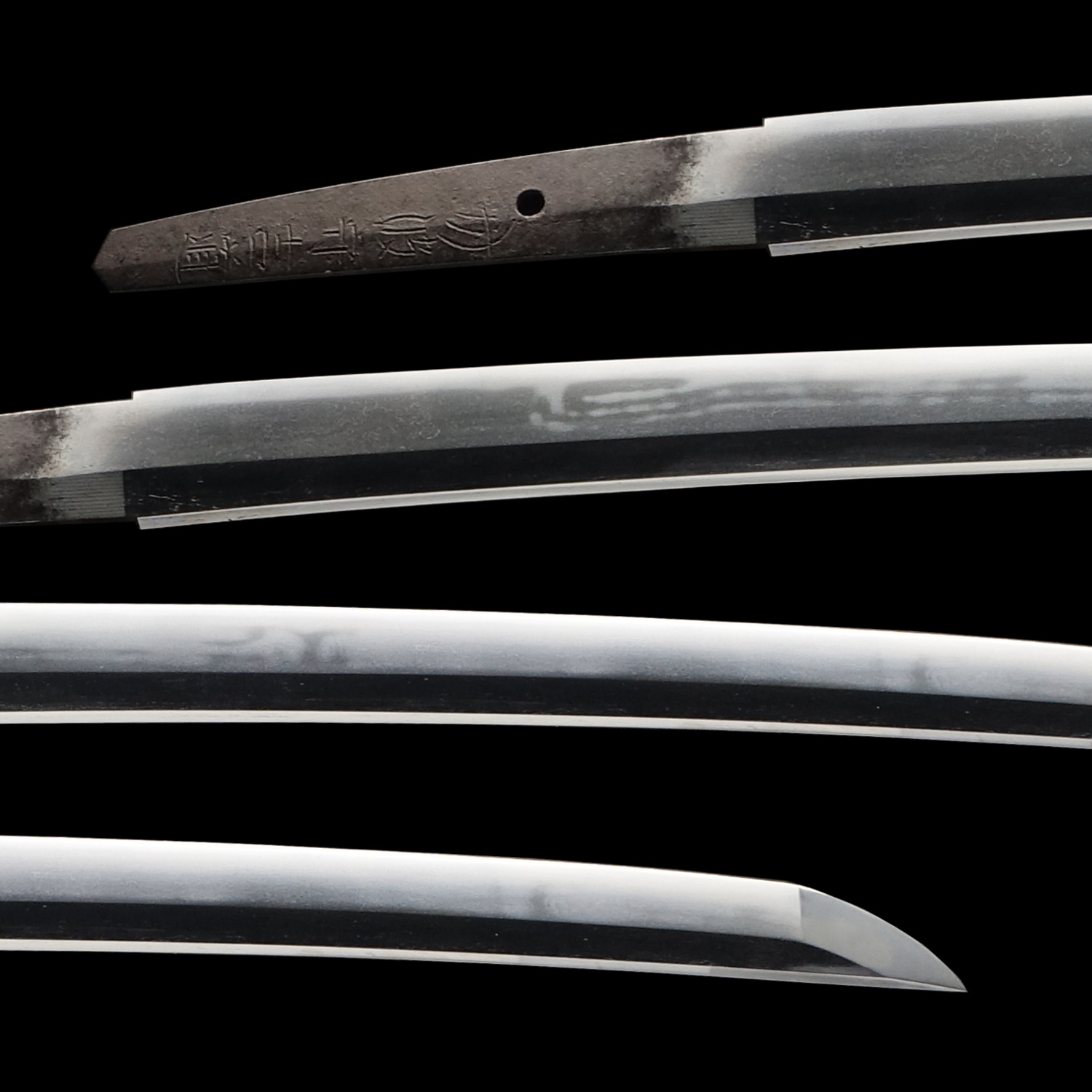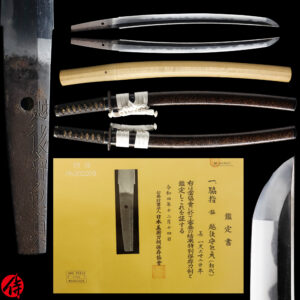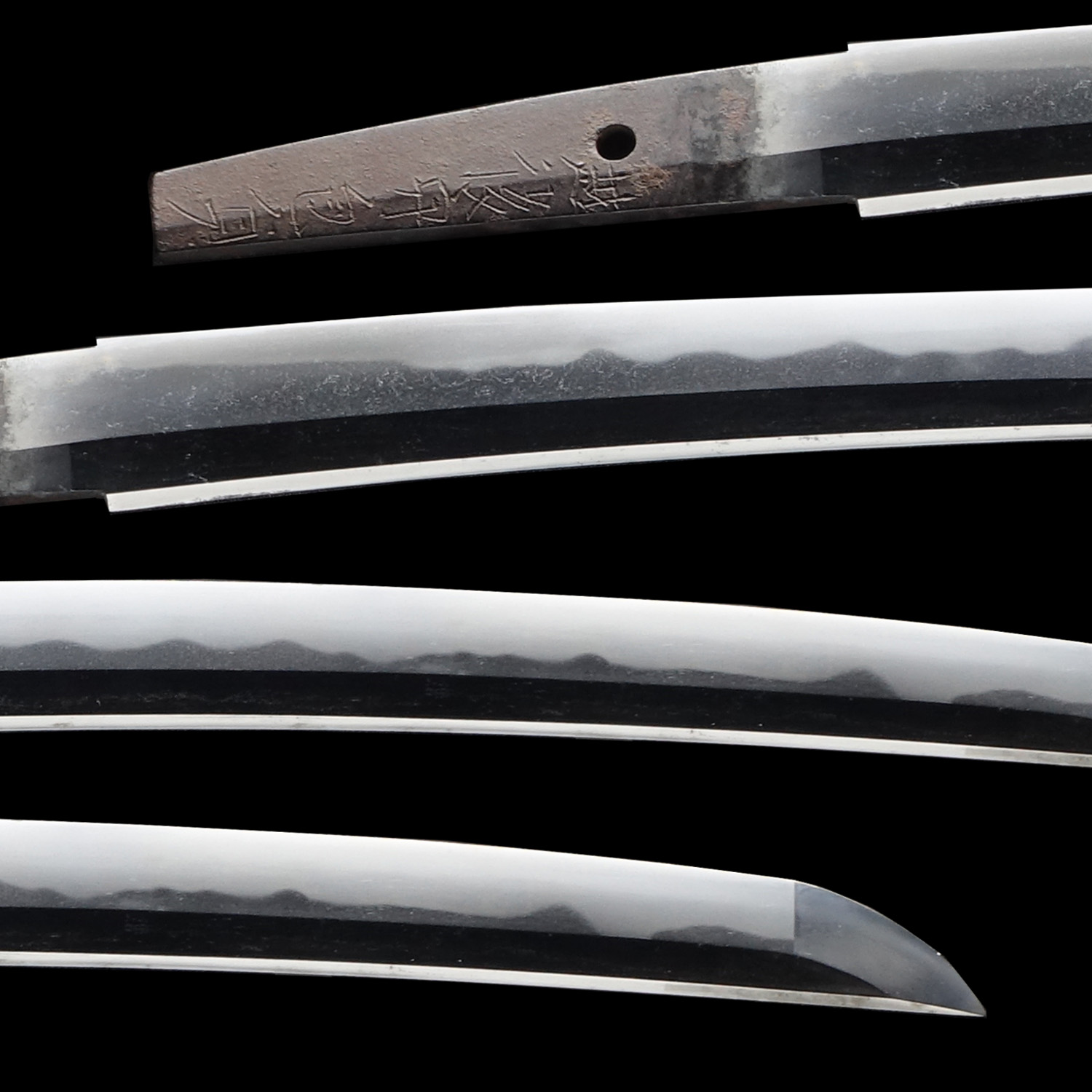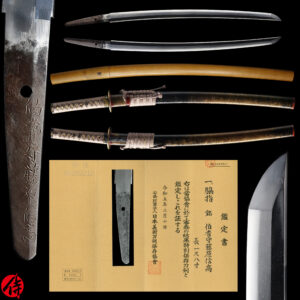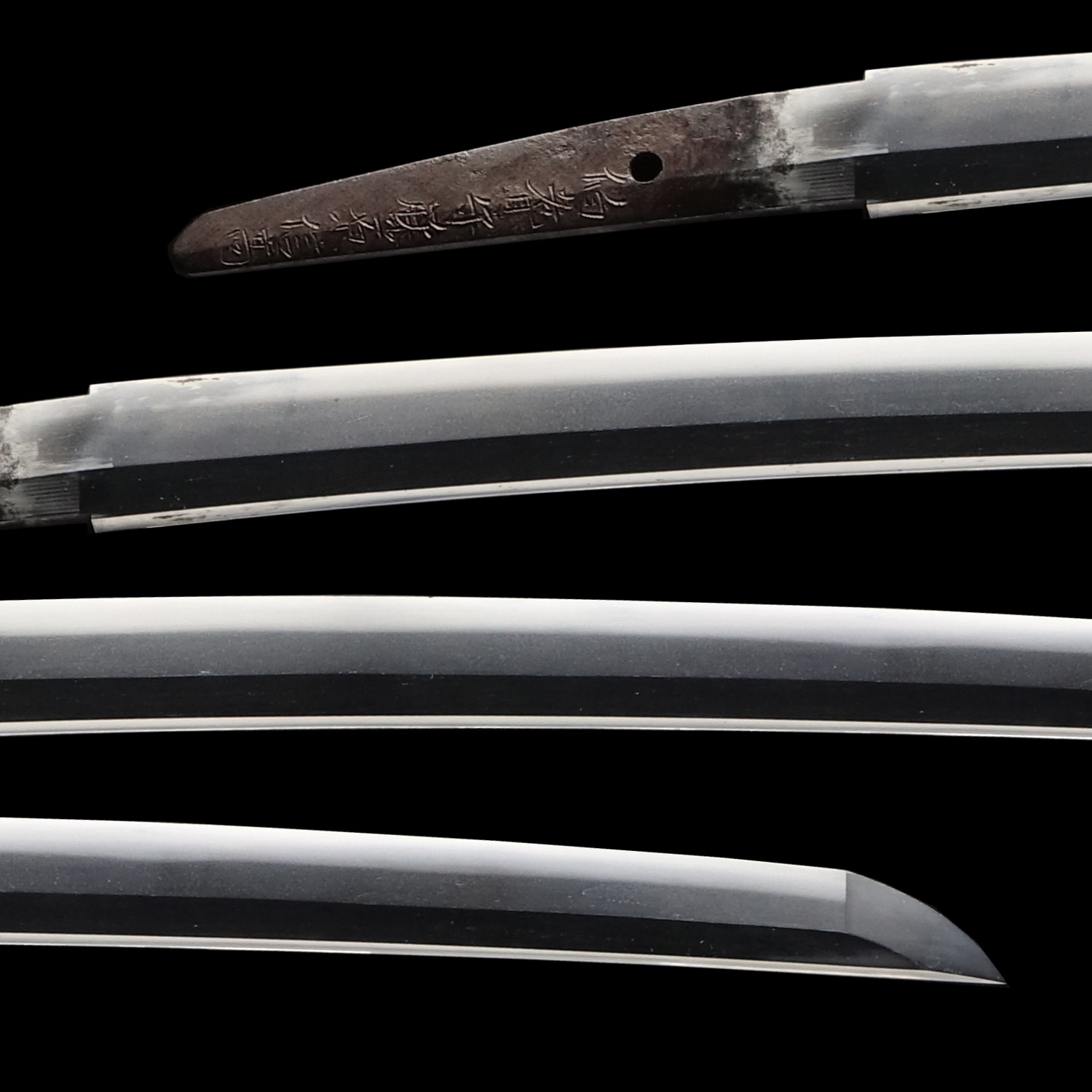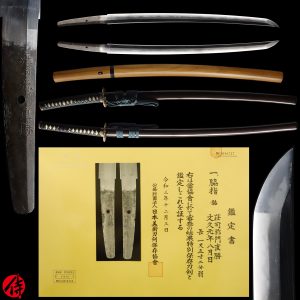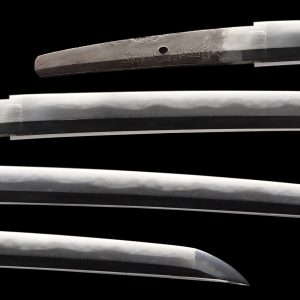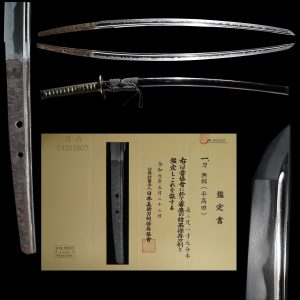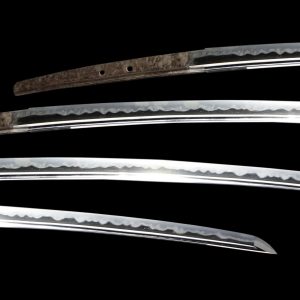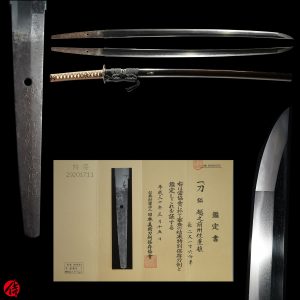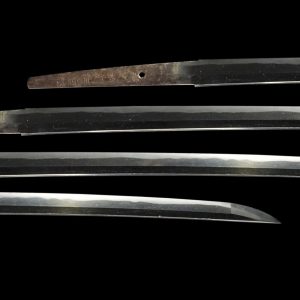Modern Authentic Japanese Sword Tanto Signed by Gassan Sadakatsu with NBTHK Tokubestsu Hozon Certificate
【Description】
Summary
This blade was signed by Gassan Sadakatsu (月山貞勝) in the 15th year of the Shōwa era (1940), a commemorative year marking the 2600th anniversary of Japan’s imperial lineage, based on the mythical founding of the nation by Emperor Jimmu in 660 BCE.
Gassan Sadakatsu was born in 1869 (2nd year of Meiji era) in Osaka’s Yariyamachi district as the eldest son of Gassan Sadakazu (初代貞一), a renowned swordsmith and Imperial Court Artist (Teishitsu Gigeiin). From a young age, he studied under his father, learning both sword-forging and the art of decorative carvings (horimono). Although he remained largely in the background during his father’s lifetime, Sadakatsu became active mainly from the Taishō period into early Shōwa, during which he forged numerous swords by imperial commission and for the Japanese Army and Navy.
His works are distinguished by their mastery of various traditional sword-forging styles, including the famed “Ayasugi-hada” (綾杉肌)—a unique, wave-like forging pattern passed down through the Gassan school. Many of his blades also feature intricate and powerful carvings.
Sadakatsu’s contributions extended beyond his own craftsmanship. He trained several exceptional smiths, including his son Gassan Sadakazu II (二代貞一) and Takahashi Sadatsugu, both of whom were later designated as Living National Treasures (Ningen Kokuhō). His influence and skill were officially recognized by the Osaka Prefecture, and it is said that news of his passing in 1943 at the age of 70 was announced with a special edition newspaper.
The History of the Gassan School
The Gassan lineage of swordsmiths dates back to the early Kamakura period, with Giohmaru, its legendary founder, who worked at the base of Mt. Gassan in Dewa Province (present-day Yamagata Prefecture). The school flourished throughout the Kamakura and Muromachi periods, developing its iconic Ayasugi-hada pattern—flowing, wave-like grain structures seen prominently on Gassan blades.
Although the school’s prominence diminished somewhat during the Edo period, its reputation remained. The famous poet Matsuo Bashō even referenced Gassan smiths in Oku no Hosomichi (The Narrow Road to the Deep North), attesting to their enduring fame.
In the late Edo period, Gassan Sadayoshi relocated to Osaka and revitalized the tradition, establishing what came to be known as the Osaka Gassan line. This revival led to a succession of highly skilled smiths including Gassan Sadakazu (the elder), Gassan Sadakatsu, and Gassan Sadakazu II, who continued the family craft despite modern challenges. Today, the Gassan legacy lives on through Gassan Sadatoshi and his successor Gassan Sadahito, who carry forward this centuries-old tradition of Japanese sword craftsmanship.
This blade is appraised as a Tokubetsu Hozon Token (特別保存刀剣) issued by NBTHK (Nihon Bijutsu Touken Hozon Kyokai:日本美術刀剣保存協会). This authentication paper was only given to authentic Japanese swords, especially well preserved and high quality with artistic value.
*Please keep in mind that there is a tiny Kitae Kizu on this blade. If you like to see the detailed condition, please feel free to contact us.
【Blade】
Cutting Edge Length(Nagasa):25.9 cm (10.1 inches)
Curvature(Sori):0.0 cm (0.0 inches)


Hamon:
The crystalline structure which forms along the cutting edge of a blade as a result of the hardening process
Jimon(Jihada):
visible steel surface pattern created by folding and hammering during forging process

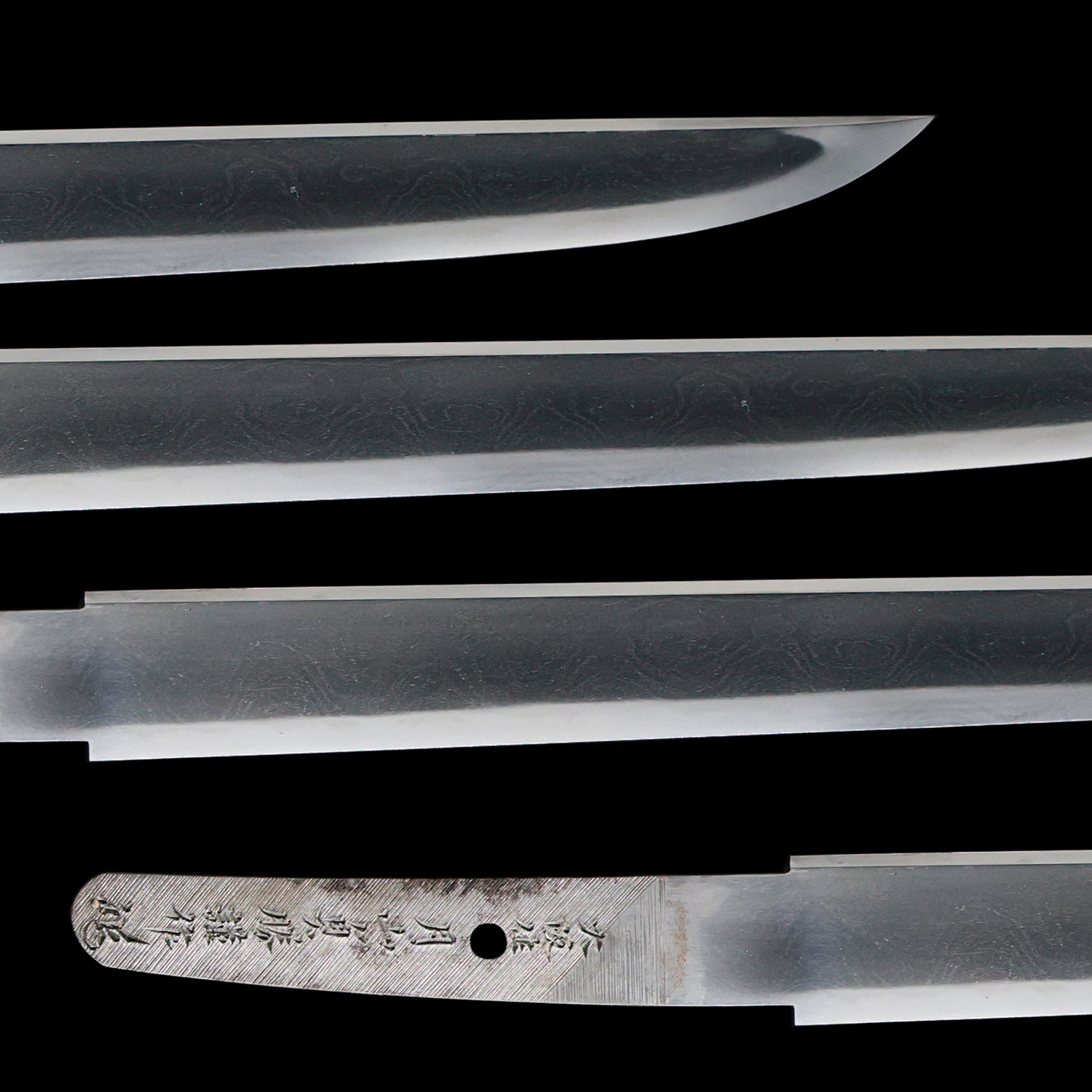



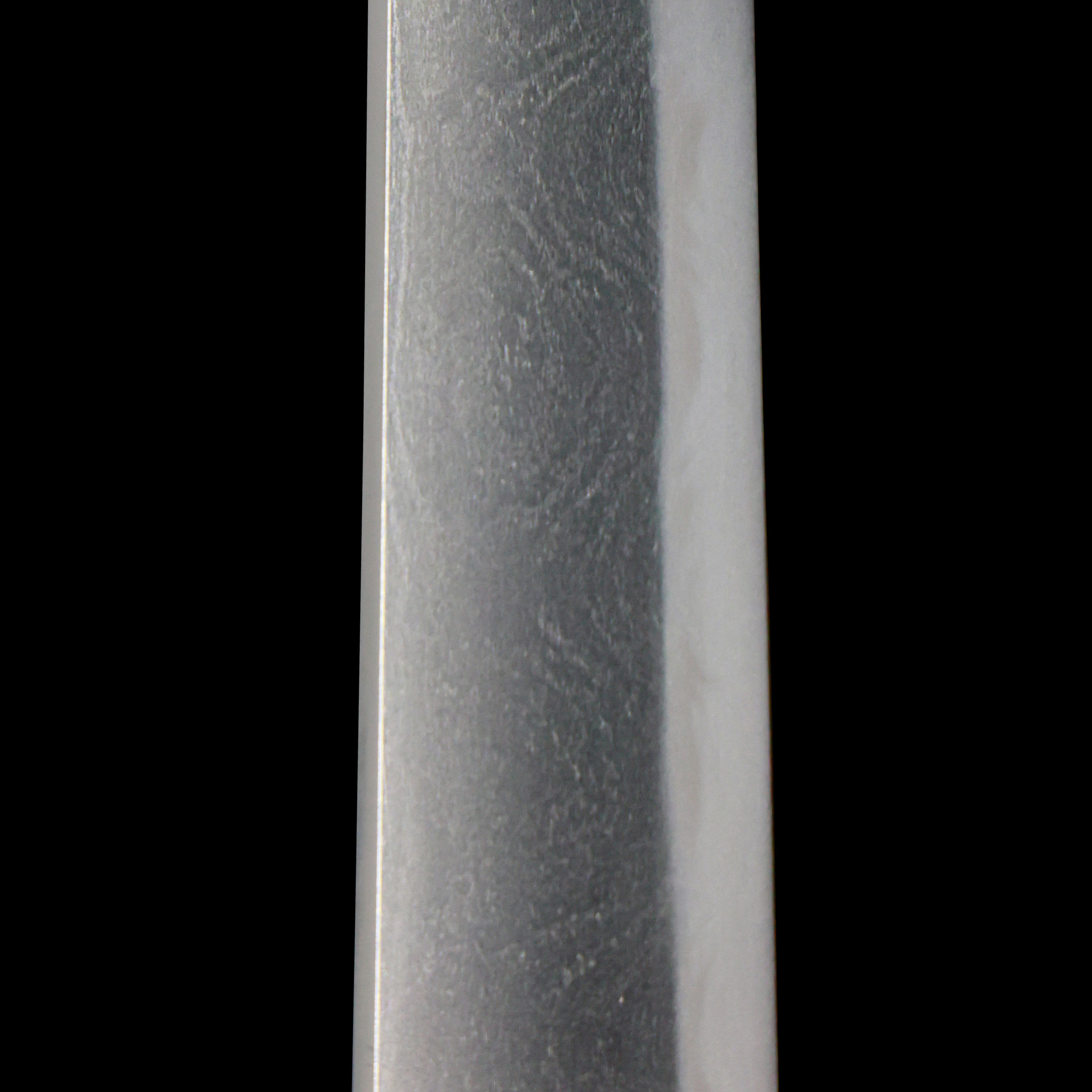
Kissaki:Kissaki is the tip of the Japanese sword.

Nakago:Nakago is the tang of the Japanese sword.
Japanese swordsmiths left the black rust on the tang because it prevents red rust while the tang is in its handle. And the discoloration of the tang was created over time, and it is a great indicator for a Japanese sword specialist to estimate when the sword was forged.
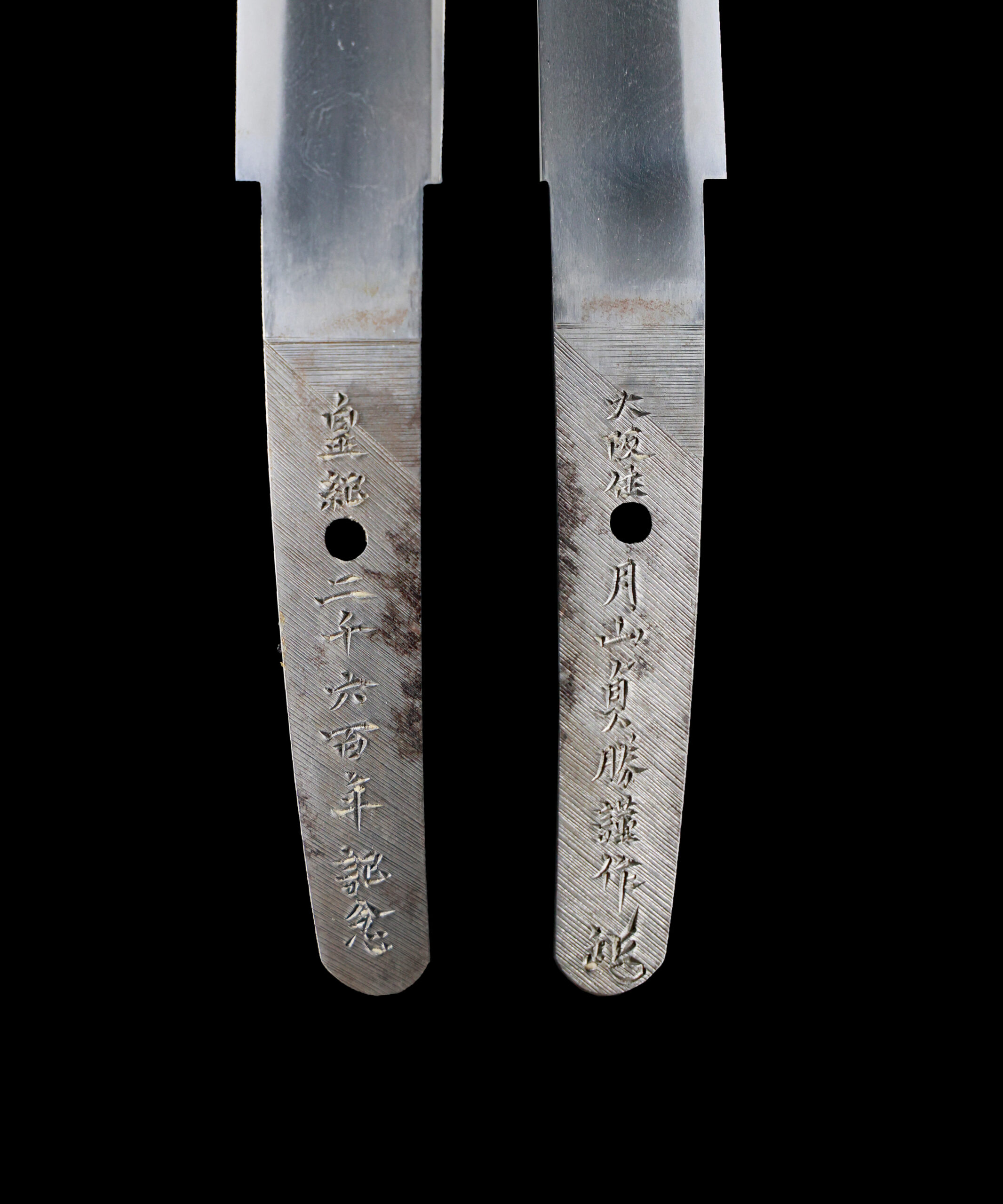
Koshirae:Koshirae is the mounting of the Japanese sword. There are several parts that consist of Koshirae such as Saya (Scabbard), Tsuka (Handle), Tsuba (Handguard).
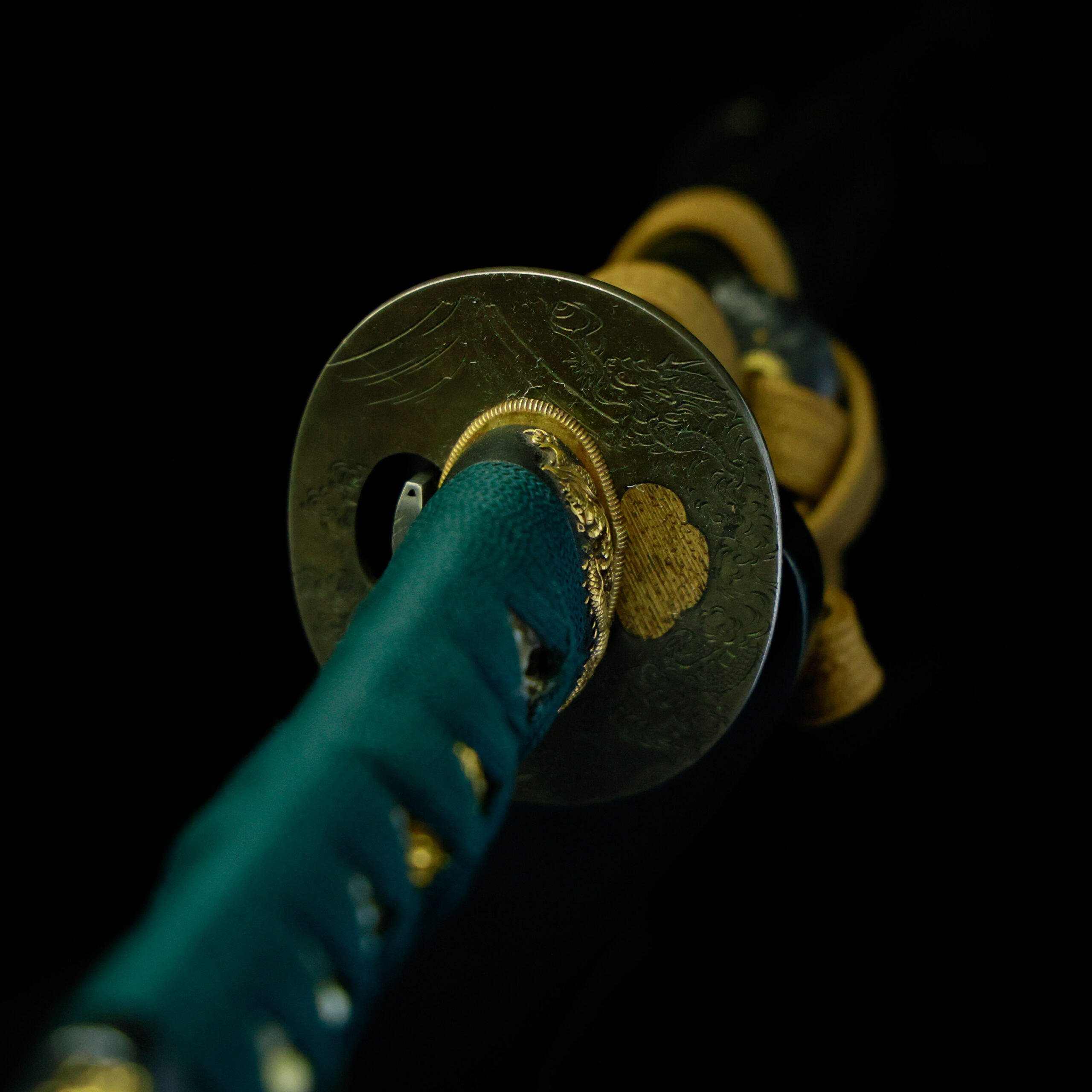
Fuchi-Kashira:A pair of matching sword fittings that cover the upper and bottom parts of its sword hilt.
The fuchi-kashira (hilt collar and pommel cap) also features a unified design depicting a dragon. According to traditional beliefs, a dragon’s body is composed of characteristics from nine different animals: antlers of a deer, ears of a cow, head of a camel, eyes of a rabbit, scales of a carp, claws of a hawk, palms of a tiger, belly of a mizuchi (a mythical Japanese water creature), and neck of a snake.
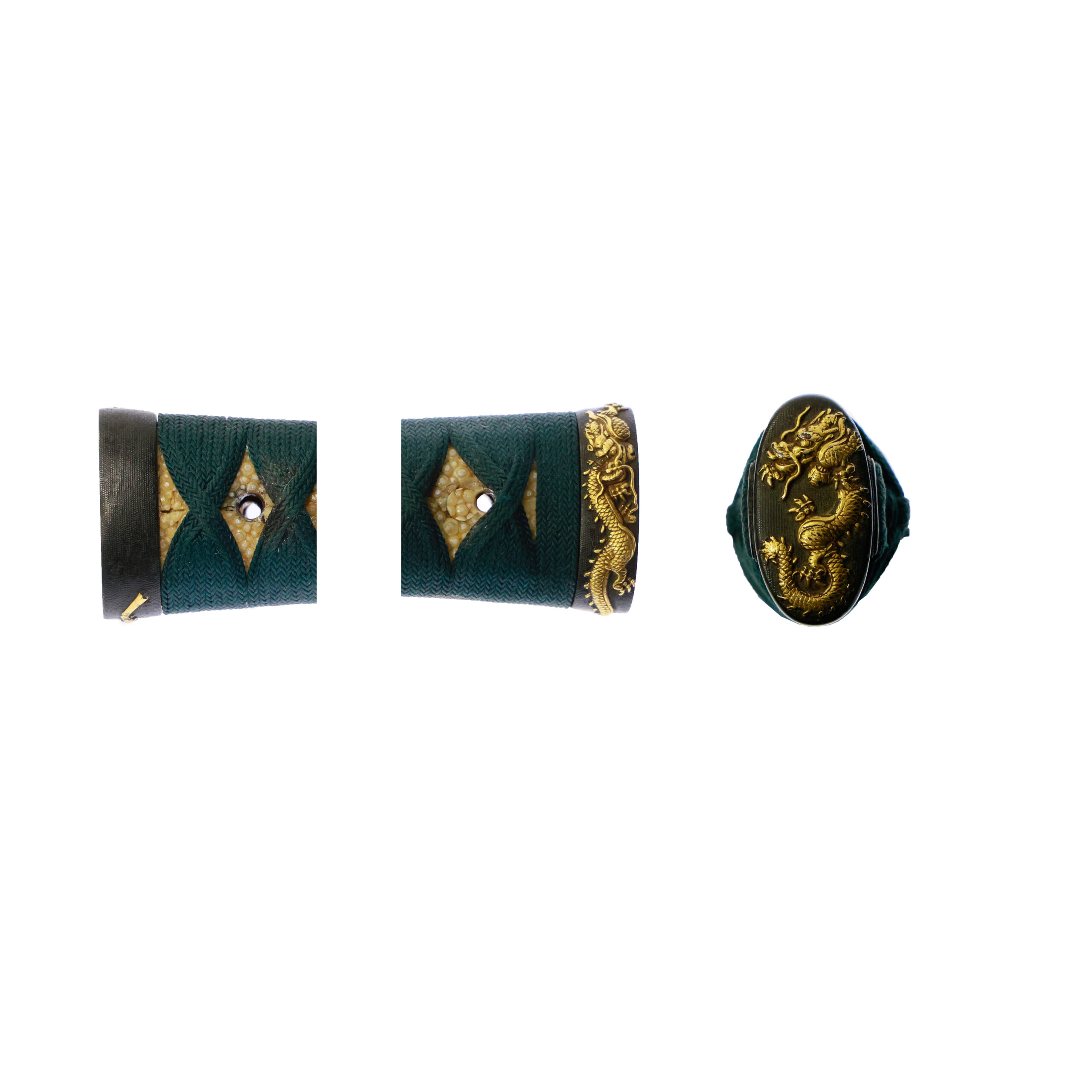
Tsuka and Menuki:Tsuka is the handle of the Japanese sword and Menuki is its decoration.
The menuki also features a dragon motif, just like the other sword fittings, rendered in fine detail using gold inlay (金象嵌, Kin zōgan) technique.


Tsuba and Habaki:Tsuba is the handguard for the Japanese Sword and Habaki is the equipment to make the blade not touch its scabbard inside. It prevents the blade from getting rusty and chipped.
This tsuba (sword guard) also features a dragon (龍, Ryu) as its central theme. Alongside the dragon, the outline of a mountain—likely Mount Fuji—can be seen, based on its distinctive shape.
In Japanese culture, Mount Fuji is regarded as a sacred mountain (霊山, reizan), symbolizing eternity, strength, and spiritual significance. The combination of the dragon, a mythical creature believed to control water and weather, with Mount Fuji, a symbol of enduring natural power, creates a deeply auspicious and culturally meaningful motif.
This imagery recalls the famous painting “Dragon Flying Over Mount Fuji” (富士越龍図, Fujikoshi Ryūzu) by Katsushika Hokusai(葛飾北斎), a celebrated ukiyo-e artist of the Edo period. Completed shortly before his death, the painting is often viewed as Hokusai’s spiritual farewell, merging the transient world with the divine through the image of a dragon ascending beyond Fuji—a powerful metaphor in both art and mythology.
Together, the dragon and Mount Fuji on this tsuba embody protection, strength, and spiritual elevation, making it not only a functional sword fitting but also an object rich in symbolic value.
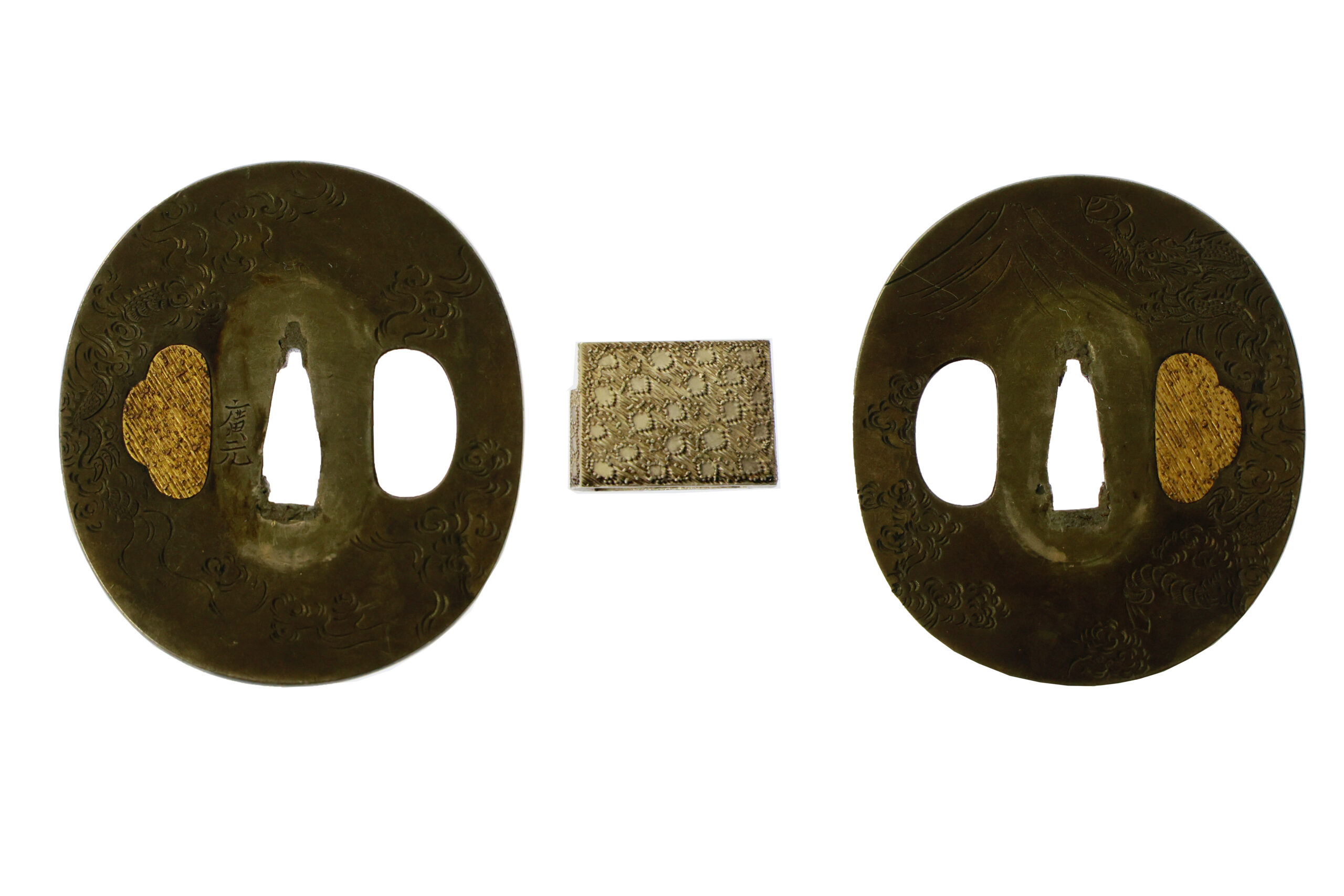
Kozuka : Kozuka is a small knife stored in Kozuka Hitsu(groove of the sheath of the Japanese sword).
The theme of the Kozuka is the dragon (龍, Ryu). Initially, the dragon is an imaginary creature found in ancient Chinese traditions or myths. Furthermore, it is regarded as a symbolic beast of auspicious signs. Its body is likened to nine animals: antlers are deer, the head is a camel, eyes are demons, the neck is a snake, belly is Mizuchi (蛟, mythical animal in Japan which looks like a snake and have a horn and four legs), scales are fish, claws are falcons, palms are tigers, and ears are cows. It was thought that the dragon would reign at the top of all animals because of its odd-looking appearance. In ancient China, the dragon pattern was used for emperors’ clothing so that people strictly defined its shape or even the number of nails. On the other hand, the dragon pattern does not have detailed rules to represent classes in Japan. However, still, it maintains its meaning as the all-purpose auspicious pattern.


Saya: Saya is the scabbard for the Japanese sword.
Waves are depicted on the kojiri (end cap) and kurigata (knob) of the scabbard. In Japan, dragons are traditionally worshipped as water deities—a belief known as Ryūjin Shinkō (竜神信仰). As rice cultivation has long been central to Japanese life, water has always been a vital resource. For this reason, dragon motifs—associated with rain, rivers, and water—have been deeply familiar and revered in Japanese culture since ancient times.
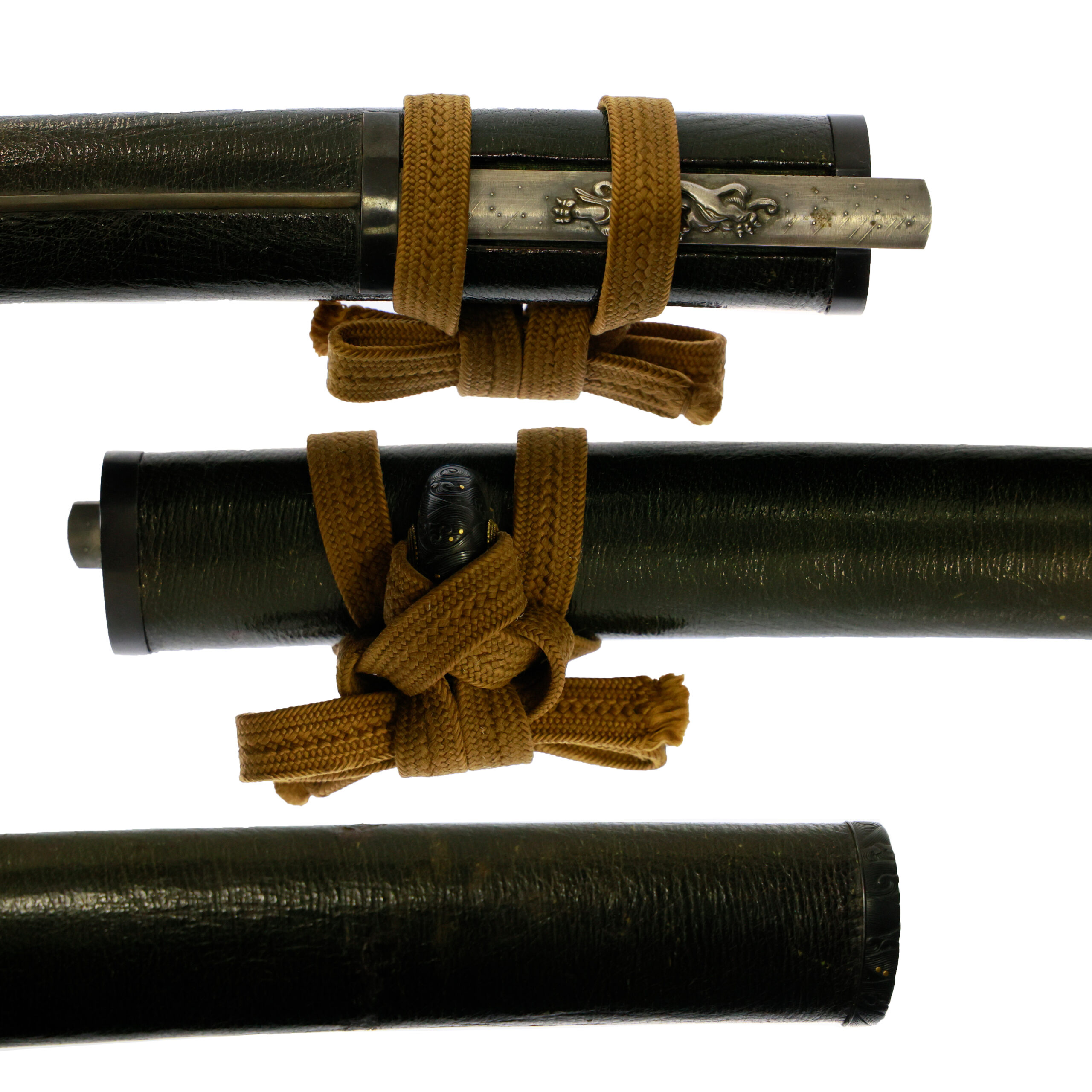
Authentication Paper:NBTHK Tokubetsu Hozon Certificate for the blade (No. 1021479)
NBTHK, also known as Nihon Bijutsu Touken Hozon Kyokai (the Society for the Preservation of the Japan Art Sword), is one of the oldest Japanese sword appraising organizations in modern-day Japan. They authenticated the blade on December 15th in the 5th year of Reiwa (2023). They appraised it as Tokubetsu Hozon Touken, the blade especially worth preserving for Japanese society. The purchaser will receive this original certificate as well. We can also translate what is written into English and make a PDF file for your record if you request.

Registration Number : Hyogo 85720
The Board of Education in Hyogo prefecture issued a registration paper for this sword. It is called Jyu Token Rui Torokusho (銃刀剣類登録証). Bunkacho (The Agency for Cultural Affairs) acknowledges a Japanese sword with this paper as a work of art.
The sword needs to be traditionally hand-forged and made of Tamahagane carbon steel to be registered in the system. With this paper, its owner in Japan can legally own an authentic Japanese sword. Based on this registration number, we will apply for its export permit.
This paper will need to be returned to the board of education when the sword is being shipped abroad, but you can receive a copy of it. An English translation of this registration paper is available on request.
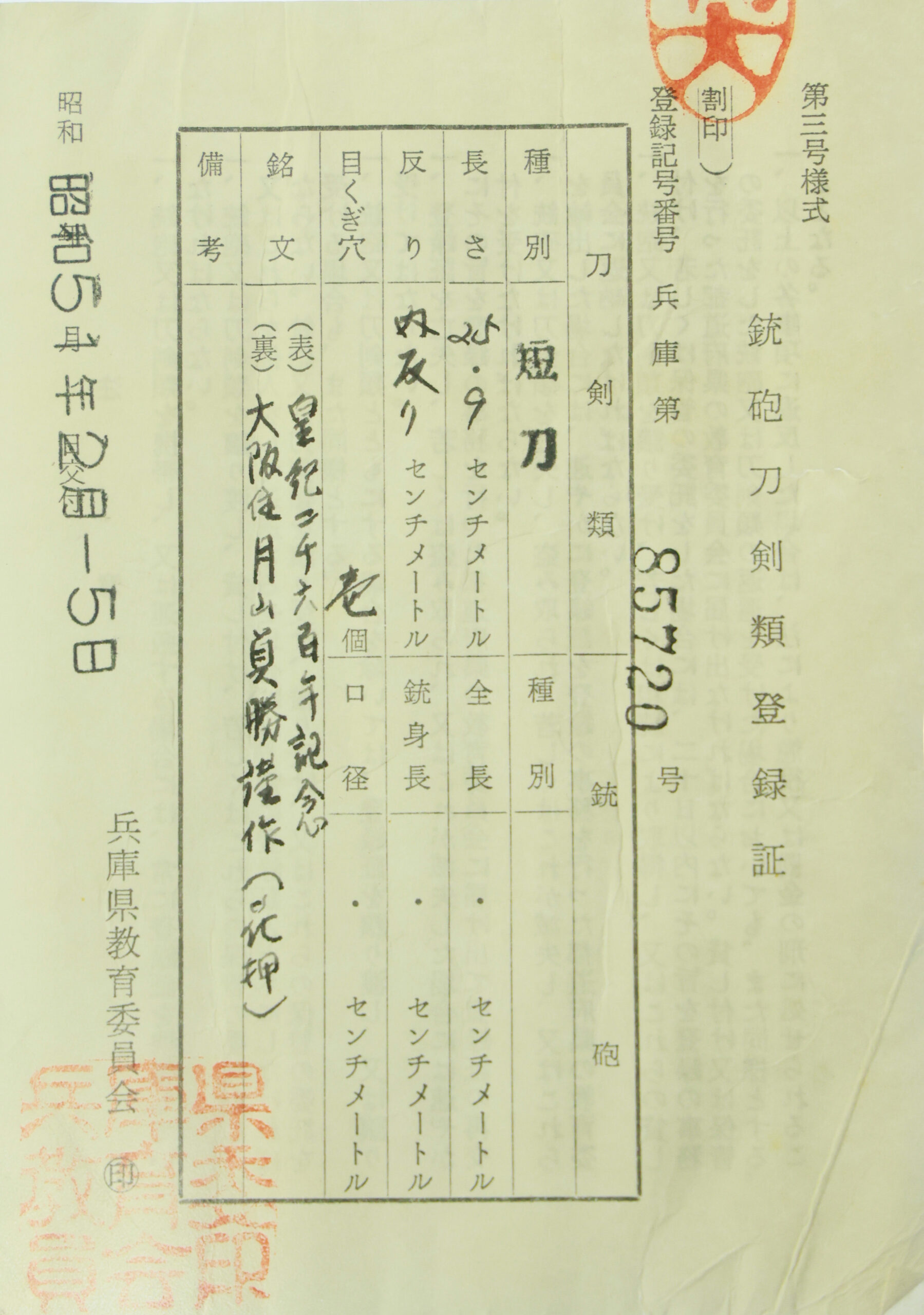

—————————————————————–
【About us】
Samurai Museum is located in Tokyo, Japan, exhibiting antique artifacts related to the Samurai history. Samurai Museum Shop is the place for those who are interested in Japanese culture and craftsmanship. We deal with antique Samurai swords/armor, traditional crafts made in Japan and so on.
【Japanese Sword& Export Process】
The Japanese swords we deal with are hand-forged edged swords made in Japan. It was made from the traditional carbon steel called TAMAHAGANE(玉鋼). Samurai Museum is familiar with the proper legal procedure for an antique/ authentic Japanese sword to be exported from Japan. We have sent more than 700 Japanese swords for the past few years (~2024) to amazing owners who appreciate its historical value.
Each Japanese sword is registered under the Agency for Cultural Affairs and the Board of Education in Japan. They issue a registration paper for each Japanese sword for its owner in Japan to legally possess it. The Japanese sword with its registration paper means it was traditionally hand-forged in Japan.
To legally export the sword from Japan to other countries, we will have to apply for its permit to the Agency for Cultural Affairs(Bunkacho) and return the original registration paper to the Board of Education. It normally takes around 2-4 weeks to receive this permit after submitting required documents. And we would like you to expect at least 1-1.5 months for your order to arrive at your given address after you ordered. For more detailed info, please click here.
It is allowed for residents in Japan to own authentic Japanese swords without a special license as long as they come with registration papers. Please feel free to contact us if you are a resident of Japan, whether temporarily or permanently. We will also assist you when you leave Japan and need to obtain the export permit.
【Payment Method】
We accept payment through Stripe (Credit card), PayPal, Apple Pay or ChromePay, all of which are secure payment methods. Also, you don’t need to make an account on Stripe for the checkout. If you prefer other payment method, please contact us. After confirming your payment, we will apply for an export permit. You may either pay in JPY, USD, AUD, CAD,EUR CHF or GBP. The price is set in Japanese Yen. Prices in other currencies are automatically calculated based on the latest exchange rate.

* If the amount is above 1 million JPY, Stripe or wire transfer will be the only options for payment.
【Shipping】
We have shipped authentic Japanese swords to the USA, Canada, Mexico, Germany , Belgium, France, Finland, Hong Kong, Australia. If you don’t live in these countries and like to order, please contact us first before making a purchase. We offer Free International Shipping as long as we can send antique Japanese swords by EMS.
We normally ship by EMS(Express Mail Service) provided by Japan Post. We will send you a tracking number for your order as soon as we hand it to the post office. We will put 100 % insurance on the shipping document without any extra charge. Based on the total amount, there might be a duty tax or other fee for you to pay, depending on the countries. We use package cushioning to protect the item and put it in a PVC pipe, which is one of the most secure packages because of its durability.
It will normally takes 5-14 days for the item to arrive at your given address after we dispatch it. Time of delivery is estimated as accurately as possible by the carrier but does not take into account any delays beyond our control such as by inclement weather, post office holiday seasons.
* If you live in Australia and like to purchase an authentic Japanese sword, please click here to know the detail.
* If you live in the UK and like to purchase an authentic Japanese sword, please contact us first and click here to know the detail.

【Review】
Here is one of the reviews we received from a customer who purchased an authentic Japanese sword from us. For more reviews, please click here.
“My experience overall with the whole process was wonderful. I had many questions about the history and process to purchase these treasures. All my questions were answered very timely and complete. The staff is very knowledgeable and very well versed if any questions do arise.”
【How to make sure the condition】
Please keep in mind that what you are going to purchase is an antique item. We uploaded high resolution photos for you to check its condition thoroughly. If you like to see more photos with different angles, please feel free to contact us. We will be happy to send them to you so that you can make informed decision. It is essential for us to know that you are happy with your choice of a sword. and we are prepared to use the best of our ability to serve you.
【How To Contact Us】
Please contact us through email, Facebook Messenger or Live Chat if you have any questions. You can find each icon on the right side of the website. Please click one of them to reach us. We will reply to you within 1-2 business days.
【The Art of Nihonto (Japanese Sword)】
Samurai’s history is a profound, eloquent legacy of ancient Japanese warriors in which millions of people worldwide are being fascinated. If you like to find out the art of Nihonto, please click here.
【A Guide to Japanese Sword Maintenance】
After acquiring an genuine Japanese sword, it is also important to know how to take good care of it. Here is the special video for you. Mr. Paul Martin, Japanese sword expert, shows you how to give proper maintenance to your sword. By mastering how to clean the Japanese sword, its aesthetic beauty will last forever.
When you purchase a Japanese sword from us, you can get a Free Japanese sword maintenance kit. It comes with four tools(Choji Oil, Uchiko Whetstone Powder, Peg remover, Oil Applicator). By watching the video instruction above , you can enjoy learning how to maintain your Japanese sword while appreciating it. If you have any difficulty assembling the sword or cleaning the blade, you can feel free to contact us.
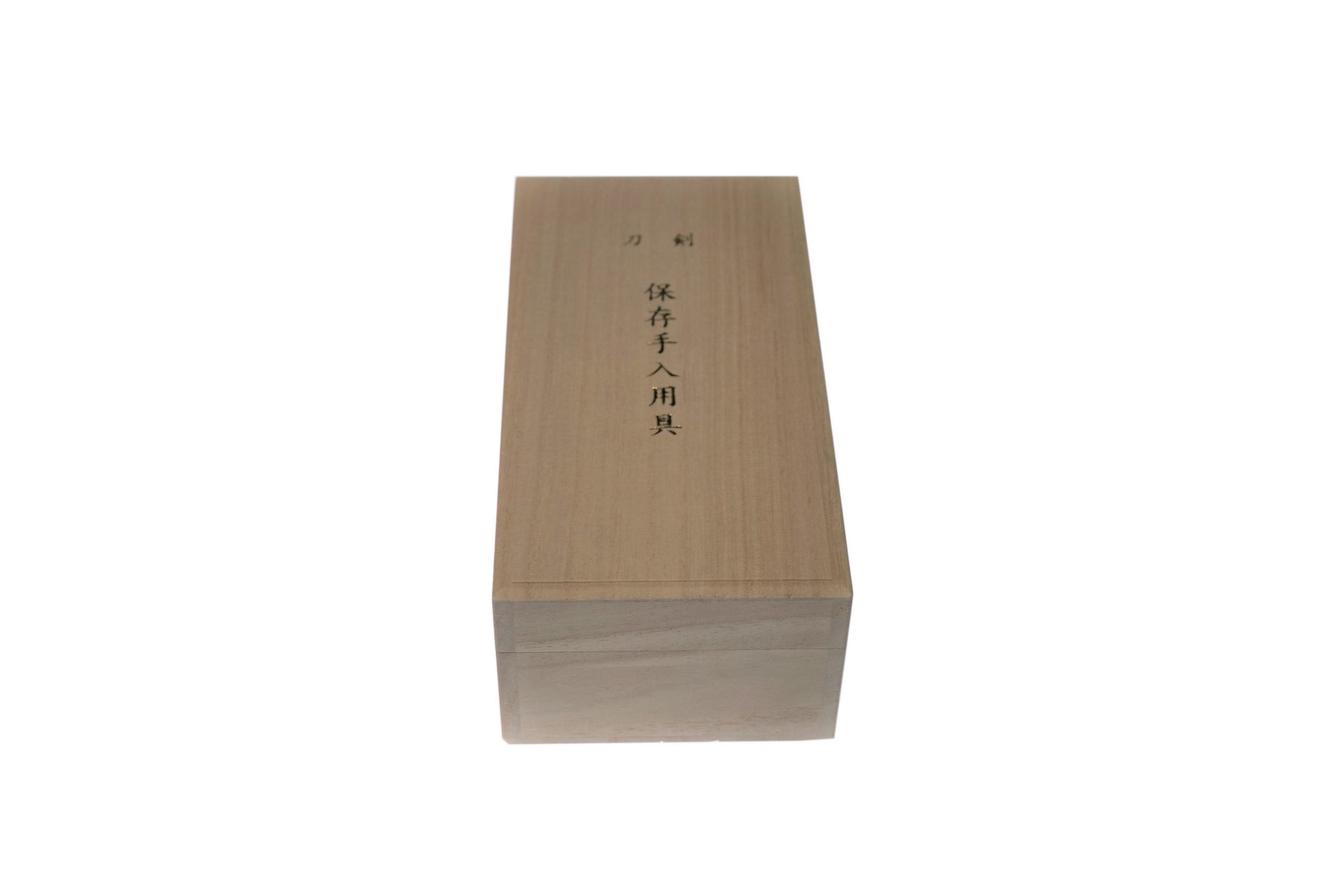
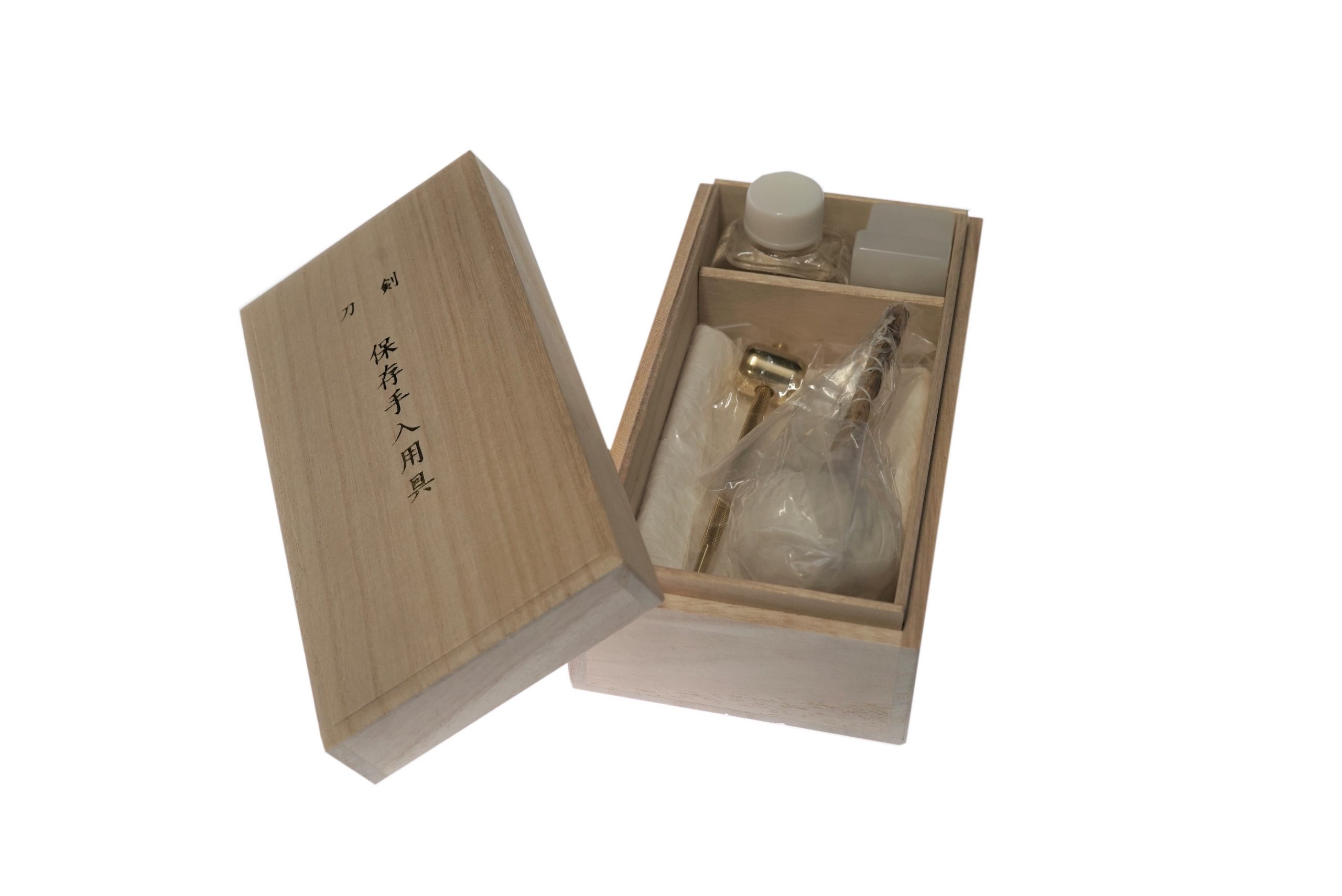
MORE ANTIQUE JAPANESE SWORD FOR SALE
SWORDS WITHOUT CERTIFICATES FOR SALE
LEARN JAPANESE SWORD TERMINOLOGY
Thank you for reading all the information on the page. If you have any difficulty choosing the right Japanese sword for you, we will be more than happy to help you find the one that speaks to you the most. Please feel free to contact us.
